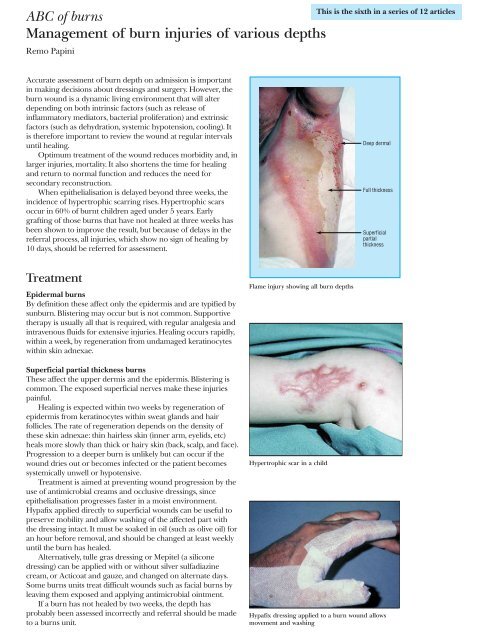ABC of Burns
You also want an ePaper? Increase the reach of your titles
YUMPU automatically turns print PDFs into web optimized ePapers that Google loves.
<strong>ABC</strong> <strong>of</strong> burns<br />
Management <strong>of</strong> burn injuries <strong>of</strong> various depths<br />
Remo Papini<br />
This is the sixth in a series <strong>of</strong> 12 articles<br />
Accurate assessment <strong>of</strong> burn depth on admission is important<br />
in making decisions about dressings and surgery. However, the<br />
burn wound is a dynamic living environment that will alter<br />
depending on both intrinsic factors (such as release <strong>of</strong><br />
inflammatory mediators, bacterial proliferation) and extrinsic<br />
factors (such as dehydration, systemic hypotension, cooling). It<br />
is therefore important to review the wound at regular intervals<br />
until healing.<br />
Optimum treatment <strong>of</strong> the wound reduces morbidity and, in<br />
larger injuries, mortality. It also shortens the time for healing<br />
and return to normal function and reduces the need for<br />
secondary reconstruction.<br />
When epithelialisation is delayed beyond three weeks, the<br />
incidence <strong>of</strong> hypertrophic scarring rises. Hypertrophic scars<br />
occur in 60% <strong>of</strong> burnt children aged under 5 years. Early<br />
grafting <strong>of</strong> those burns that have not healed at three weeks has<br />
been shown to improve the result, but because <strong>of</strong> delays in the<br />
referral process, all injuries, which show no sign <strong>of</strong> healing by<br />
10 days, should be referred for assessment.<br />
Deep dermal<br />
Full thickness<br />
Superficial<br />
partial<br />
thickness<br />
Treatment<br />
Epidermal burns<br />
By definition these affect only the epidermis and are typified by<br />
sunburn. Blistering may occur but is not common. Supportive<br />
therapy is usually all that is required, with regular analgesia and<br />
intravenous fluids for extensive injuries. Healing occurs rapidly,<br />
within a week, by regeneration from undamaged keratinocytes<br />
within skin adnexae.<br />
Superficial partial thickness burns<br />
These affect the upper dermis and the epidermis. Blistering is<br />
common. The exposed superficial nerves make these injuries<br />
painful.<br />
Healing is expected within two weeks by regeneration <strong>of</strong><br />
epidermis from keratinocytes within sweat glands and hair<br />
follicles. The rate <strong>of</strong> regeneration depends on the density <strong>of</strong><br />
these skin adnexae: thin hairless skin (inner arm, eyelids, etc)<br />
heals more slowly than thick or hairy skin (back, scalp, and face).<br />
Progression to a deeper burn is unlikely but can occur if the<br />
wound dries out or becomes infected or the patient becomes<br />
systemically unwell or hypotensive.<br />
Treatment is aimed at preventing wound progression by the<br />
use <strong>of</strong> antimicrobial creams and occlusive dressings, since<br />
epithelialisation progresses faster in a moist environment.<br />
Hypafix applied directly to superficial wounds can be useful to<br />
preserve mobility and allow washing <strong>of</strong> the affected part with<br />
the dressing intact. It must be soaked in oil (such as olive oil) for<br />
an hour before removal, and should be changed at least weekly<br />
until the burn has healed.<br />
Alternatively, tulle gras dressing or Mepitel (a silicone<br />
dressing) can be applied with or without silver sulfadiazine<br />
cream, or Acticoat and gauze, and changed on alternate days.<br />
Some burns units treat difficult wounds such as facial burns by<br />
leaving them exposed and applying antimicrobial ointment.<br />
If a burn has not healed by two weeks, the depth has<br />
probably been assessed incorrectly and referral should be made<br />
to a burns unit.<br />
Flame injury showing all burn depths<br />
Hypertrophic scar in a child<br />
Hypafix dressing applied to a burn wound allows<br />
movement and washing



